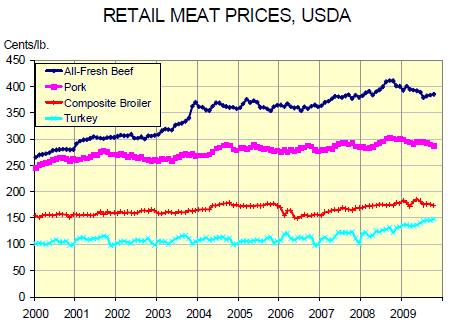



CME: Turkey Sales in October a Success
US - According to Steve Meyer and Len Steiner, retail beef and pork prices remained well below year-ago levels in October while retail broiler prices fell below year-ago levels and retail turkey prices rose to 21 per cent higher than during last October.Those data came from USDA’s Economic Research Service this week. The data are based on retail prices gathered in October by the Bureau of Labor Statistics.

The average price for all fresh beef rose slightly in October to $3.851/lb. That is $.013/lb. higher than in September and but still 7.3 per cent lower than the October 2008 price of $4.109/lb. The October increase is the third straight since retail beef prices hit their year-todate low of $3.79/lb in July.
Pork price fell again in October, but the decline to $2.88/lb. was less than 1 per cent lower than the September price of $2.906/lb. The October pork price was 4.6 per cent lower than one year ago. That is not much of a surprise given the string of record or near-record pork disappearance months we have seen since exports faltered, largely due to H1N1 influenza back in April. Monday’s September trade data has allowed us to confirm that domestic pork disappearance set a new record for September this year.
Retail broiler prices averaged $1.735/lb. in October, 0.3 per cent lower than one year ago and 1.4 per cent lower than in September. Retail chicken prices will still very likely set a record high annual average this year after hitting a monthly record high of $1.857/lb. in May.
The species having the most success in pushing retail prices higher is turkey, whose price set another new record in October at $1.48/lb. The previous record of $1.461/lb. was set in August and October marks the sixth record-high monthly average price this year. The reason is pretty obvious: The turkey sector has reduced output far more than have the other species with year-to-date slaughter down 5.2 per cent versus last year and yearto- date production down 5.7 per cent versus last year through last Friday.
Domestic beef , chicken and turkey availability are all lower thus far in 2009 but only turkey prices are higher at the retail level. We believe those relationships are symptomatic of the ongoing (or perhaps just-finished, depending on who you read or talk to) recession where downturns in the foodservice trade have forced more beef and chicken through retail channels. Turkey’s price strength has very likely been a function of the recession as well as consumers traded down to lower-cost turkey based cold cuts and prepared meats. Even though US pork production is 1.8 per cent lower than one year ago through last week, domestic pork availability (and thus consumption) is higher. Higher pork supplies mean that retail pork prices should actually be lower than they have been this year if demand had been stable. So, among the major meat types, it appears that only pork demand is at or above last year’s levels.
We pointed out in the first paragraph that these data are based on retail price data gathered each month by the Bureau of Labor Statistics. We have mentioned several times in these pages that a resumption of USDA’s scanner-based retail price data was expected this fall but it now appears that is not going to happen. ERS has never been comfortable gathering and publishing these data and that discomfort is understandable. ERS is a research organization, not a price gathering and reporting organization. They publish the BLS-based retail price data only because is it a part of their monthly meat price spreads calculations. So, ERS has decided not to resume purchasing scanner data after bids came in this summer above the price they expected and a recently released ERS study found that there the scanner data is “less useful than BLS data for analyzing current market conditions.” The report can be found by clicking here.
The logical agency to gather retail price data is the Agricultural Marketing Service but that agency has no funding for the project, so the scanner-based system is in peril even though an improved system was a feature of the Livestock Mandatory Reporting Act of 1999, the law that, among other things, created the mandatory price reporting system for hogs, cattle, lambs and wholesale beef and lamb cuts. The BLS data have their strengths but they are based on far fewer retail cuts than they once were, raising some doubts about how well the data represent the weighted average retail value of all cuts. There will hopefully be more to this story.











